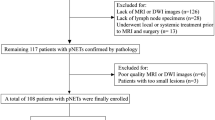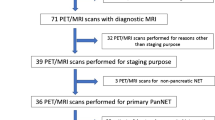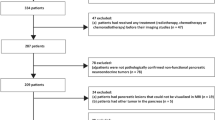Abstract
Purpose
To evaluate the value of MR imaging features in stratifying Grade 2 (G2) pancreatic neuroendocrine tumors (PNETs) using the 5% cut-off value of the Ki-67 index as reference standards.
Materials and methods
Between January 2010 and October 2016, 41 G2 PNET patients (One patient had 3 tumors) with preoperative MR imaging were included. Tumor grading was based on the revised 2016 World Health Organization classification of PNETs. MR imaging features included size, shape, consistency, T1-w and T2-w signal intensities, enhancement pattern, apparent diffusion coefficient (ADC) ratios (tumor/normal pancreatic parenchyma).
Results
16 Ki-67 index < 5% tumors (SKIT, 37.2%) and 27 Ki-67 index ≥ 5% tumors (LKIT, 62.8%) of G2 were evaluated. The LKIT showed solid consistency (85% vs. 50%, P < 0.05), incomplete envelope-like reinforcement in a delayed phase (74% vs. 62%, P < 0.05), and liver or lymph node metastases (67% vs. 31%, P < 0.05) more frequently than did SKIT. However, ADC ratios of LKIT were smaller than SKIT (0.85 ± 0.23 vs. 1.29 ± 0.39, P = 0.001). Using binary logistic regression analysis, the ADC ratio was an independent significant differentiator of SKIT from LKIT. The AUROC of ADC ratios was 0.816 ± 0.07. The optimal cut-off value for the identification of LKIT was 1.25 × 10−3 (sensitivity 96.3%, specificity 62.5%).
Conclusion
MRI features may identify the overbroad scope of G2 PNETs and help predict Ki-67 values, as a surrogate for tumor aggressiveness, in G2 PNETs. An optimal cut-off value for predicting Ki-67 status (≥/< 5%) was 1.25 × 10−3 of ADC ratio.




Similar content being viewed by others
References
Halfdanarson TR, Rabe KG, Rubin J, Petersen GM (2008) Pancreatic neuroendocrine tumors (PNETs): incidence, prognosis and recent trend toward improved survival. Ann Oncol 19:1727–1733
Zhu H, Ying L, Tang W, Yang X, Sun B (2017) Can MDCT or EUS features predict the histopathological grading scheme of pancreatic neuroendocrine neoplasms. Radiol Med 122:319–326
Falconi M, Eriksson B, Kaltsas G, et al. (2016) ENETS consensus guidelines update for the management of patients with functional pancreatic neuroendocrine tumors and non-functional pancreatic neuroendocrine tumors. Neuroendocrinology 103:153–171
Scarpa A, Chang DK, Nones K, et al. (2017) Whole-genome landscape of pancreatic neuroendocrine tumours. Nature 543:65–71
Ricci C, Casadei R, Taffurelli G, et al. (2014) WHO 2010 classification of pancreatic endocrine tumors. Is the new always better than the old. Pancreatology 14:539–541
Zerbi A, Falconi M, Rindi G, et al. (2010) Clinicopathological features of pancreatic endocrine tumors: a prospective multicenter study in Italy of 297 sporadic cases. Am J Gastroenterol 105:1421–1429
Scarpa A, Mantovani W, Capelli P, et al. (2010) Pancreatic endocrine tumors: improved TNM staging and histopathological grading permit a clinically efficient prognostic stratification of patients. Mod Pathol 23:824–833
Lotfalizadeh E, Ronot M, Wagner M, et al. (2017) Prediction of pancreatic neuroendocrine tumour grade with MR imaging features: added value of diffusion-weighted imaging. Eur Radiol 27:1748–1759
Jeon SK, Lee JM, Joo I, et al. (2017) Nonhypervascular pancreatic neuroendocrine tumors: differential diagnosis from pancreatic ductal adenocarcinomas at MR imaging-retrospective cross-sectional study. Radiology 284:77–87
De Robertis R, Cingarlini S, Tinazzi MP, et al. (2017) Pancreatic neuroendocrine neoplasms: magnetic resonance imaging features according to grade and stage. World J Gastroenterol 23:275–285
Yamamoto Y, Okamura Y, Uemura S, et al. (2017) Vascularity and tumor size are significant predictors for recurrence after resection of a pancreatic neuroendocrine tumor. Ann Surg Oncol 24:2363–2370
Ansari NA, Ramalho M, Semelka RC, et al. (2015) Role of magnetic resonance imaging in the detection and characterization of solid pancreatic nodules: an update. World J Radiol 7:361–374
De Robertis R, D’Onofrio M, Zamboni G, et al. (2016) Pancreatic neuroendocrine neoplasms: clinical value of diffusion-weighted imaging. Neuroendocrinology 103:758–770
Kasajima A, Yazdani S, Sasano H (2015) Pathology diagnosis of pancreatic neuroendocrine tumors. J Hepatobiliary Pancreat Sci 22:586–593
Barral M, Sebbag-Sfez D, Hoeffel C, et al. (2013) Characterization of focal pancreatic lesions using normalized apparent diffusion coefficient at 1.5-Tesla: preliminary experience. Diagn Interv Imaging 94:619–627
Luo Y, Dong Z, Chen J, et al. (2014) Pancreatic neuroendocrine tumours: correlation between MSCT features and pathological classification. Eur Radiol 24:2945–2952
Singhi AD, Chu LC, Tatsas AD, et al. (2012) Cystic pancreatic neuroendocrine tumors: a clinicopathologic study. Am J Surg Pathol 36:1666–1673
Salaria SN, Shi C (2016) Pancreatic neuroendocrine tumors. Surg Pathol Clin 9:595–617
Honda H, Onitsuka H, Yasumori K, et al. (1993) Intrahepatic peripheral cholangiocarcinoma: two-phased dynamic incremental CT and pathologic correlation. J Comput Assist Tomogr 17:397–402
Hashim YM, Trinkaus KM, Linehan DC, et al. (2014) Regional lymphadenectomy is indicated in the surgical treatment of pancreatic neuroendocrine tumors (PNETs). Ann Surg 259:197–203
Panzuto F, Merola E, Rinzivillo M, et al. (2014) Advanced digestive neuroendocrine tumors: metastatic pattern is an independent factor affecting clinical outcome. Pancreas 43:212–218
Rindi G, Falconi M, Klersy C, et al. (2012) TNM staging of neoplasms of the endocrine pancreas: results from a large international cohort study. J Natl Cancer Inst 104:764–777
Acknowledgements
The authors state that this work has not received any grants. M.S. Zeng would like to declare that the whole article was original research that has not been published previously, and not under consideration for publication elsewhere.
Author information
Authors and Affiliations
Corresponding author
Ethics declarations
Conflict of interest
Author Yabin Hu declares that he has no conflict of interest. Author Shengxiang Rao declares that he has no conflict of interest. Author Xiaolin Xu declares that she has no conflict of interest. Author Yibo Tang declares that she has no conflict of interest. Author Mengsu Zeng declares that he has no conflict of interest.
Ethical approval
All procedures performed in studies involving human participants were in accordance with the ethical standards of the institutional and/or national research committee and with the 1964 Helsinki declaration and its later amendments or comparable ethical standards.
Informed consent
As this is a retrospective study, informed consent from the patients was not required.
Rights and permissions
About this article
Cite this article
Hu, Y., Rao, S., Xu, X. et al. Grade 2 pancreatic neuroendocrine tumors: overbroad scope of Ki-67 index according to MRI features. Abdom Radiol 43, 3016–3024 (2018). https://doi.org/10.1007/s00261-018-1573-5
Published:
Issue Date:
DOI: https://doi.org/10.1007/s00261-018-1573-5




